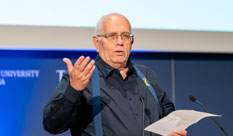More:
News & Stories
Design project as a therapeutic process
How do issues such as body image, self-confidence, sustainability and others become projects whose role is to raise awareness and serve the environment while at the same time contribute to self-discovery and understanding as part of a self-healing process?
Project by Chen Mazuz, first year graduate
Body image, sustainability, youth striving for responsibility, integrating the LGBT community into the urban space and others, are some of the topics presented in the outstanding projects' exhibition of 1st to 3rd year students in the Department of Interior Design.
This Exhibition, which is traditionally held at the Vitrina Gallery, at the beginning of each academic year, presents 18 selected projects that deal with topics close to the students' worlds and hearts.
Design and art are often used as therapeutic tools, as they directly touch the veins of the inner soul and often make it possible to bring out issues that have never been addressed or spoken about. There is something about connecting with the inner self, even as part of a school or academic task that makes it possible to express the intricacies of the mind. In retrospect it turns out that such processes have done no less successful a work than psychological therapy.
Chen Mazuz, a first-year graduate
For example, Chen Mazuz, a first-year graduate, chose to deal with the issue of body image, or rather with the effect that clothes have on our body. "The marks that clothes sometimes leave on the body, are part of the boundaries that society dictates to us," she says. "The environment expects me to look in a certain way that is not necessarily comfortable or suitable for me. For years I have internalized the demands of society and the issue of my body image never came up for discussion. In pursuit of this project I have found myself flooded with emotions and issues that never came out."
Inspired by this experience, Chen designed an object that is worn on the neck which makes it very upright, but disables speaking. "My immediate association was of a fascinating yet speechless doll, all due to harsh social rules and norms".
When she thought of how to allow women to speak despite the limitations of society or the environment and inspired by the object, Chen designed an empowerment space for women, a meeting place where they can talk, exchange experiences and ideas, hear and be heard. "I've experienced a kind of healing while working on the project," she says. "As I continued to create I felt I was growing and expressing internal issues that I had not addressed so far."
Romi Strauss, a second-year graduate
Romi Strauss, a second-year graduate, made a project dealing with sustainability. She chose a classroom at the Democratic School in Jaffa and designed it with fragments of building materials and created an interesting and new look that is entirely made of materials that are reused. Beyond the aesthetic aspect, there is also an educational emphasis for the school's children who will learn in the classroom to apply, to notice the design that surrounds them and to understand how simple and accessible it can be made with the right thinking that encourages concern for the environment. The project was submitted to a sustainable buildings competition.
These and other projects are on display until the end of the month at the Vitrina Gallery in Building 6.
Udi Cramsky, Head of the Interior Design Department: "This exhibition presents a wide range of projects. In the first year they deal with a person's intimate space, second year projects deal with combining community and surroundings, 3rd year projects deal with detailed interiors of small business spaces. You're all invited.
Posted: 21/10/2021
- News & Events
New Collaboration with Sheba Medical Center will qualify nurses to work in a digital environment.
Collaboration between HIT Holon Institute of Technology, the teaching authority of the Sheba Medical Center, and the Sheba-BEYOND virtual hospital will allow training nurses in Israel and around the world to work in a digital...



 Additional programs
Additional programs
